Courses

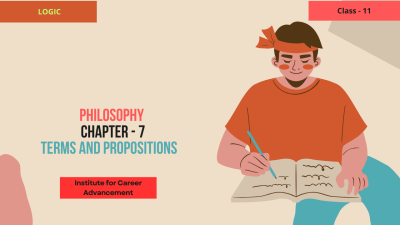
 Compare
Compare
In the context of logic, terms and propositions are fundamental building blocks of arguments. Terms A term is a single, indivisible concept expressed by a word or phrase. It can be classified based on its quantity (singular or plural) and quality (concrete or abstract). Singular terms: Refer to a specific individual or object (e.g., "Socrates," "the Eiffel Tower"). Plural terms: Refer to a group of individuals or objects (e.g., "students," "countries"). Concrete terms: Refer to things that can be perceived by the senses (e.g., "table," "chair"). Abstract terms: Refer to ideas, qualities, or concepts that cannot be perceived by the senses (e.g., "justice," "love"). Propositions A proposition is a declarative sentence that is either true or false. It expresses a complete thought and can be the subject of logical analysis. Types of propositions: Simple propositions: Express a single thought (e.g., "The sky is blue"). Compound propositions: Combine two or more simple propositions using logical connectives (e.g., "It is raining and the sun is shining"). Categorical propositions: These are statements that affirm or deny a relationship between two classes or categories. They are further classified into four types: Universal Affirmative (A): All S are P (e.g., All humans are mortal). Universal Negative (E): No S are P (e.g., No dogs are birds). Particular Affirmative (I): Some S are P (e.g., Some cats are black). Particular Negative (O): Some S are not P (e.g., Some students are not hardworking). Understanding terms and propositions is crucial for logical reasoning and argumentation. By analyzing the structure and content of propositions, we can evaluate the validity and soundness of arguments and draw logical conclusions. যুক্তির প্রসঙ্গে, শর্তাবলী এবং প্রস্তাবগুলি যুক্তির মৌলিক ভিত্তি। শর্তাবলী একটি শব্দ হল একটি একক, অবিভাজ্য ধারণা যা একটি শব্দ বা বাক্যাংশ দ্বারা প্রকাশিত হয়। এর পরিমাণ (একবচন বা বহুবচন) এবং গুণমানের ভিত্তিতে এটিকে শ্রেণীবদ্ধ করা যেতে পারে। (concrete or abstract). একক পদঃ একটি নির্দিষ্ট ব্যক্তি বা বস্তুর উল্লেখ করুন। (e.g., "Socrates," "the Eiffel Tower"). বহুবচনঃ ব্যক্তি বা বস্তুর একটি গোষ্ঠী উল্লেখ করুন। (e.g., "students," "countries"). কংক্রিট পদঃ ইন্দ্রিয় দ্বারা উপলব্ধি করা যায় এমন জিনিসগুলি উল্লেখ করুন (e.g., "table," "chair"). বিমূর্ত পদঃ ধারণা, গুণাবলী বা ধারণাগুলি উল্লেখ করুন যা ইন্দ্রিয় দ্বারা উপলব্ধি করা যায় না। (e.g., "justice," "love"). প্রস্তাবগুলি প্রস্তাব হল একটি ঘোষণামূলক বাক্য যা সত্য বা মিথ্যা হয়। এটি একটি সম্পূর্ণ চিন্তাভাবনা প্রকাশ করে এবং যৌক্তিক বিশ্লেষণের বিষয় হতে পারে। প্রস্তাবের প্রকারঃ সহজ পরামর্শঃ একটিমাত্র চিন্তা প্রকাশ করুন (e.g., "The sky is blue"). যৌগিক প্রস্তাবঃ লজিক্যাল কানেক্টিভ ব্যবহার করে দুই বা ততোধিক সহজ প্রস্তাবনা একত্রিত করুন। (e.g., "It is raining and the sun is shining"). শ্রেণীগত প্রস্তাবনাঃ এগুলি এমন বিবৃতি যা দুটি শ্রেণী বা বিভাগের মধ্যে সম্পর্ককে নিশ্চিত বা অস্বীকার করে। এগুলিকে আরও চার শ্রেণীতে ভাগ করা হয়েছেঃ সর্বজনীন ইতিবাচক (A) সমস্ত S হল P (e.g., All humans are mortal). সর্বজনীন নেতিবাচক (ই) কোন এস হয় পি (e.g., No dogs are birds). বিশেষ ইতিবাচক (I) কিছু এস হল পি (e.g., Some cats are black). বিশেষ নেতিবাচক (ও) কিছু এস পি নয় (e.g., Some students are not hardworking). যৌক্তিক যুক্তি এবং যুক্তির জন্য শর্তাবলী এবং প্রস্তাবগুলি বোঝা অত্যন্ত গুরুত্বপূর্ণ। প্রস্তাবনাগুলির কাঠামো এবং বিষয়বস্তু বিশ্লেষণ করে, আমরা যুক্তির বৈধতা এবং দৃঢ়তা মূল্যায়ন করতে পারি এবং যৌক্তিক সিদ্ধান্তে পৌঁছাতে পারি।
0 Lessons
Hours
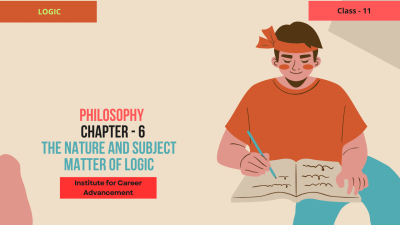
 Compare
Compare
This topic introduces students to the fundamental concepts and principles of logic. It explores the nature of reasoning, argumentation, and the tools used to evaluate the validity and soundness of arguments. Key Concepts: Nature of Logic: Logic as the science of correct reasoning. Its role in critical thinking and problem-solving. The distinction between formal and informal logic. Subject Matter of Logic: Propositions: Declarative sentences that are either true or false. Arguments: A set of statements, one or more of which (the premises) are offered as reasons for accepting another (the conclusion). Inference: The process of drawing conclusions from premises. Deductive Reasoning: Drawing conclusions that are necessarily true if the premises are true. Inductive Reasoning: Drawing probable conclusions based on evidence and observations. Laws of Thought: Law of Identity: A thing is identical with itself. Law of Non-Contradiction: A thing cannot be both A and not-A at the same time and in the same respect. Law of Excluded Middle: A thing must either be A or not-A. এই বিষয়টি শিক্ষার্থীদের যুক্তির মৌলিক ধারণা এবং নীতিগুলির সাথে পরিচয় করিয়ে দেয়। এটি যুক্তি, যুক্তি এবং যুক্তির বৈধতা এবং দৃঢ়তা মূল্যায়নের জন্য ব্যবহৃত সরঞ্জামগুলির প্রকৃতি অন্বেষণ করে। মূল ধারণাগুলিঃ যুক্তির প্রকৃতিঃ সঠিক যুক্তির বিজ্ঞান হিসাবে যুক্তি। সমালোচনামূলক চিন্তাভাবনা এবং সমস্যা সমাধানে এর ভূমিকা। আনুষ্ঠানিক এবং অনানুষ্ঠানিক যুক্তির মধ্যে পার্থক্য। যুক্তির বিষয়ঃ প্রস্তাবনাঃ ঘোষণামূলক বাক্য যা সত্য বা মিথ্যা। যুক্তিঃ বিবৃতিগুলির একটি সেট, যার মধ্যে এক বা একাধিক (প্রাঙ্গণ) অন্যটি গ্রহণের কারণ হিসাবে দেওয়া হয় (the conclusion). অনুমানঃ প্রাঙ্গণ থেকে সিদ্ধান্ত নেওয়ার প্রক্রিয়া। ডিডাক্টিভ রিজনিং (deductive Reasoning): এমন সিদ্ধান্ত নেওয়া যা ভিত্তি সত্য হলে অবশ্যই সত্য। আবেগময় যুক্তিঃ প্রমাণ এবং পর্যবেক্ষণের উপর ভিত্তি করে সম্ভাব্য সিদ্ধান্ত নেওয়া। চিন্তার নিয়মঃ পরিচয়ের নিয়মঃ একটি জিনিস নিজের সাথে অভিন্ন। অ-দ্বন্দ্বের আইনঃ একটি জিনিস একই সময়ে এবং একই ক্ষেত্রে এ এবং না-এ উভয়ই হতে পারে না। বাদ দেওয়া মধ্যের আইনঃ একটি জিনিস অবশ্যই A বা না-A হতে হবে।
₹599
0 Lessons
Hours
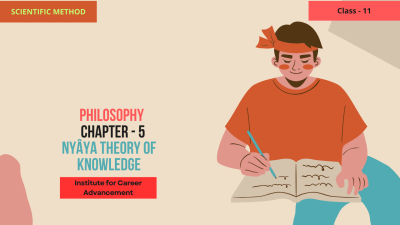
 Compare
Compare
The Nyāya Theory of Knowledge in Class 11 explores an ancient Indian philosophical system that offers a framework for understanding how we acquire knowledge. Key Concepts: Pramāṇa: This is the central concept, referring to the valid means of gaining knowledge. Nyāya recognizes four pramāṇas: Pratyakṣa (Perception): Direct experience through the senses (sight, sound, touch, taste, smell). Anumāna (Inference): Drawing conclusions based on reasoning and evidence. Upamāna (Comparison and Analogy): Gaining knowledge by comparing an unknown object to a known one. Śabda (Testimony): Acquiring knowledge through reliable sources, such as scriptures and the words of experts. Focus on Logic and Reason: Nyāya emphasizes the importance of logical reasoning and critical thinking in acquiring knowledge. Epistemological Concerns: The Nyāya school delves into questions about the nature of knowledge, the validity of different sources of knowledge, and the criteria for distinguishing between true and false beliefs. একাদশ শ্রেণীর জ্ঞানের ন্যায় তত্ত্ব একটি প্রাচীন ভারতীয় দার্শনিক ব্যবস্থার অন্বেষণ করে যা আমরা কীভাবে জ্ঞান অর্জন করি তা বোঝার জন্য একটি কাঠামো সরবরাহ করে। মূল ধারণাগুলিঃ প্রমাণঃ এই হল কেন্দ্রীয় ধারণা, যা জ্ঞান অর্জনের বৈধ উপায়কে নির্দেশ করে। ন্যায় চারটি প্রমাণকে স্বীকৃতি দেয়ঃ প্রত্যক্ষা (উপলব্ধি) ইন্দ্রিয়ের মাধ্যমে প্রত্যক্ষ অভিজ্ঞতা (sight, sound, touch, taste, smell). অনুমানা (অনুমান) যুক্তি ও প্রমাণের ভিত্তিতে সিদ্ধান্ত গ্রহণ। উপমান (তুলনা এবং সাদৃশ্য) একটি অজানা বস্তুর সাথে পরিচিত বস্তুর তুলনা করে জ্ঞান অর্জন করা। শব্দ (সাক্ষ্য) নির্ভরযোগ্য উৎসের মাধ্যমে জ্ঞান অর্জন করা, যেমন ধর্মগ্রন্থ এবং বিশেষজ্ঞদের কথা। যুক্তি এবং যুক্তির উপর মনোনিবেশ করুনঃ জ্ঞান অর্জনে যুক্তিসঙ্গত যুক্তি এবং সমালোচনামূলক চিন্তাভাবনার গুরুত্বের উপর ন্যায় জোর দেয়। জ্ঞানতাত্ত্বিক উদ্বেগঃ ন্যায় বিদ্যালয় জ্ঞানের প্রকৃতি, জ্ঞানের বিভিন্ন উৎসের বৈধতা এবং সত্য ও মিথ্যা বিশ্বাসের মধ্যে পার্থক্য করার মানদণ্ড সম্পর্কে প্রশ্নগুলি নিয়ে আলোচনা করে।
₹599
0 Lessons
Hours
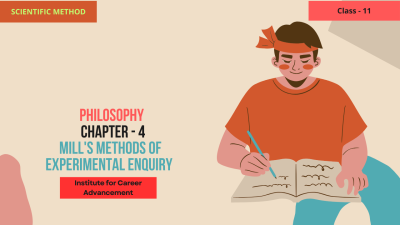
 Compare
Compare
Mill's Methods of Experimental Enquiry for Class 11 focus on the principles developed by philosopher John Stuart Mill to identify causal relationships through systematic observation and experimentation. These methods help determine cause-and-effect relationships by analyzing patterns in experimental data. Key Methods: Method of Agreement: If two or more instances of a phenomenon share a common factor, that factor is likely the cause of the effect. Method of Difference: If a phenomenon occurs in one case but not in another, the factor that is present in the first case but absent in the second is likely the cause of the observed effect. Joint Method of Agreement and Difference: Combines the first two methods to strengthen the argument for causal inference by examining both the presence and absence of common factors. Method of Residues: After accounting for known causes of an effect, the remaining unexplained effect is likely due to a new or residual cause. Method of Concomitant Variation: If two variables vary together in a consistent manner, one may be causing the other. These methods provide students with a structured approach to reasoning through scientific observations and experiments, allowing them to deduce causal relationships and improve experimental inquiry. মিল 'স মেথডস অফ এক্সপেরিমেন্টাল এনকোয়ারি ফর ক্লাস 11 দার্শনিক জন স্টুয়ার্ট মিল দ্বারা বিকশিত নীতিগুলির উপর দৃষ্টি নিবদ্ধ করে পদ্ধতিগত পর্যবেক্ষণ এবং পরীক্ষার মাধ্যমে কার্যকারণ সম্পর্ক সনাক্ত করতে। এই পদ্ধতিগুলি পরীক্ষামূলক তথ্যের নিদর্শনগুলি বিশ্লেষণ করে কারণ এবং প্রভাবের সম্পর্ক নির্ধারণ করতে সহায়তা করে। মূল পদ্ধতিঃ চুক্তির পদ্ধতিঃ যদি কোনও ঘটনার দুই বা ততোধিক উদাহরণ একটি সাধারণ ফ্যাক্টর ভাগ করে নেয়, তবে সেই ফ্যাক্টরটি সম্ভবত প্রভাবের কারণ। পার্থক্যের পদ্ধতিঃ যদি একটি ঘটনা এক ক্ষেত্রে ঘটে কিন্তু অন্য ক্ষেত্রে না ঘটে, তবে প্রথম ক্ষেত্রে উপস্থিত কিন্তু দ্বিতীয় ক্ষেত্রে অনুপস্থিত ফ্যাক্টরটি সম্ভবত পর্যবেক্ষিত প্রভাবের কারণ। চুক্তি এবং পার্থক্যের যৌথ পদ্ধতিঃ সাধারণ কারণগুলির উপস্থিতি এবং অনুপস্থিতি উভয়ই পরীক্ষা করে কার্যকারণ অনুমানের জন্য যুক্তি জোরদার করার জন্য প্রথম দুটি পদ্ধতির সংমিশ্রণ। অবশিষ্টাংশের পদ্ধতিঃ কোনও প্রভাবের জ্ঞাত কারণগুলি হিসাব করার পরে, অবশিষ্ট অব্যক্ত প্রভাব সম্ভবত কোনও নতুন বা অবশিষ্ট কারণের কারণে হয়। সঙ্গতিপূর্ণ পরিবর্তনের পদ্ধতিঃ যদি দুটি চলক সামঞ্জস্যপূর্ণভাবে একসাথে পরিবর্তিত হয়, তবে একটি অন্যটির কারণ হতে পারে। এই পদ্ধতিগুলি শিক্ষার্থীদের বৈজ্ঞানিক পর্যবেক্ষণ এবং পরীক্ষার মাধ্যমে যুক্তির জন্য একটি কাঠামোগত পদ্ধতি প্রদান করে, যা তাদের কার্যকারণ সম্পর্ক অনুমান করতে এবং পরীক্ষামূলক অনুসন্ধানের উন্নতি করতে দেয়।
0 Lessons
Hours
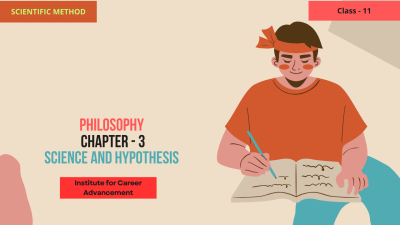
 Compare
Compare
Science and Hypothesis in Class 11 delves into the core principles that drive scientific inquiry. It explores the crucial role of hypotheses in the scientific method and how they guide investigations. Key Concepts: Hypothesis: A testable prediction or explanation for a phenomenon. It's an educated guess based on observations and existing knowledge. Characteristics of a Good Hypothesis: Testable: Can be supported or refuted through experimentation or observation. Falsifiable: Can be proven wrong. Specific and Measurable: Clearly defined and allows for quantitative data collection. Formulating Hypotheses: Based on observations, previous research, and existing knowledge. Using "if-then" statements to express relationships between variables. Testing Hypotheses: Designing experiments or conducting observations to gather data. Analyzing data to determine if the hypothesis is supported or refuted. Role of Hypotheses in Science: Drive scientific investigations and guide research. Help to organize and interpret observations. Lead to new discoveries and advancements in knowledge. Why Study Science and Hypothesis in Class 11? Fosters Critical Thinking: Develops critical thinking and problem-solving skills by encouraging students to analyze information, formulate hypotheses, and evaluate evidence. Underpins Scientific Inquiry: Provides a foundational understanding of the scientific method and how it's used to investigate the natural world. Enhances Research Skills: Improves research skills by teaching students how to formulate research questions, develop hypotheses, and design experiments. Prepares for Higher Education: Essential for students pursuing science, technology, engineering, and mathematics (STEM) fields. Cultivates Curiosity: Encourages curiosity and a desire to explore the unknown. By studying Science and Hypothesis, students gain a deeper understanding of the scientific process and develop the skills necessary for independent inquiry and critical thinking. একাদশ শ্রেণিতে বিজ্ঞান এবং অনুমান বৈজ্ঞানিক অনুসন্ধানকে চালিত করে এমন মূল নীতিগুলি নিয়ে আলোচনা করে। এটি বৈজ্ঞানিক পদ্ধতিতে অনুমানের গুরুত্বপূর্ণ ভূমিকা এবং কীভাবে তারা তদন্তকে পরিচালনা করে তা অন্বেষণ করে। মূল ধারণাগুলিঃ অনুমানঃ একটি ঘটনার জন্য একটি পরীক্ষামূলক ভবিষ্যদ্বাণী বা ব্যাখ্যা। এটি পর্যবেক্ষণ এবং বিদ্যমান জ্ঞানের উপর ভিত্তি করে একটি শিক্ষিত অনুমান। একটি ভাল অনুমানের বৈশিষ্ট্যঃ পরীক্ষামূলকঃ পরীক্ষা বা পর্যবেক্ষণের মাধ্যমে সমর্থন বা প্রত্যাখ্যান করা যেতে পারে। মিথ্যেঃ ভুল প্রমাণিত হতে পারে। নির্দিষ্ট এবং পরিমাপযোগ্যঃ স্পষ্টভাবে সংজ্ঞায়িত এবং পরিমাণগত তথ্য সংগ্রহের অনুমতি দেয়। অনুমান প্রণয়নঃ পর্যবেক্ষণ, পূর্ববর্তী গবেষণা এবং বিদ্যমান জ্ঞানের উপর ভিত্তি করে। চলকের মধ্যে সম্পর্ক প্রকাশ করতে "যদি-তাহলে" বিবৃতি ব্যবহার করা। অনুমান পরীক্ষা করাঃ তথ্য সংগ্রহের জন্য পরীক্ষা-নিরীক্ষা করা বা পর্যবেক্ষণ পরিচালনা করা। অনুমানটি সমর্থিত বা প্রত্যাখ্যাত কিনা তা নির্ধারণের জন্য তথ্য বিশ্লেষণ করা। বিজ্ঞানে অনুমানের ভূমিকাঃ বৈজ্ঞানিক অনুসন্ধান পরিচালনা করুন এবং গবেষণা পরিচালনা করুন। পর্যবেক্ষণগুলি সংগঠিত ও ব্যাখ্যা করতে সহায়তা করুন। জ্ঞানের ক্ষেত্রে নতুন আবিষ্কার এবং অগ্রগতির দিকে পরিচালিত করে। কেন একাদশ শ্রেণিতে বিজ্ঞান এবং অনুমান অধ্যয়ন করবেন? সমালোচনামূলক চিন্তাভাবনাকে উৎসাহিত করেঃ শিক্ষার্থীদের তথ্য বিশ্লেষণ, অনুমান প্রণয়ন এবং প্রমাণ মূল্যায়ন করতে উৎসাহিত করে সমালোচনামূলক চিন্তাভাবনা এবং সমস্যা সমাধানের দক্ষতা বিকাশ করে। আন্ডারপিন্স বৈজ্ঞানিক অনুসন্ধানঃ বৈজ্ঞানিক পদ্ধতি এবং প্রাকৃতিক বিশ্বের তদন্তের জন্য এটি কীভাবে ব্যবহৃত হয় সে সম্পর্কে একটি মৌলিক ধারণা প্রদান করে। গবেষণা দক্ষতা বৃদ্ধিঃ শিক্ষার্থীদের গবেষণা প্রশ্ন প্রণয়ন, অনুমান বিকাশ এবং পরীক্ষার নকশা তৈরি করতে শেখানোর মাধ্যমে গবেষণা দক্ষতা উন্নত করে। উচ্চ শিক্ষার জন্য প্রস্তুতিঃ বিজ্ঞান, প্রযুক্তি, প্রকৌশল এবং গণিত (স্টেম) ক্ষেত্রে অধ্যয়নরত শিক্ষার্থীদের জন্য প্রয়োজনীয়। কৌতূহল গড়ে তোলেঃ কৌতূহল এবং অজানা অন্বেষণ করার আকাঙ্ক্ষাকে উৎসাহিত করে। বিজ্ঞান ও অনুমান অধ্যয়নের মাধ্যমে শিক্ষার্থীরা বৈজ্ঞানিক প্রক্রিয়া সম্পর্কে গভীর ধারণা অর্জন করে এবং স্বাধীন অনুসন্ধান ও সমালোচনামূলক চিন্তাভাবনার জন্য প্রয়োজনীয় দক্ষতার বিকাশ ঘটায়।
0 Lessons
Hours
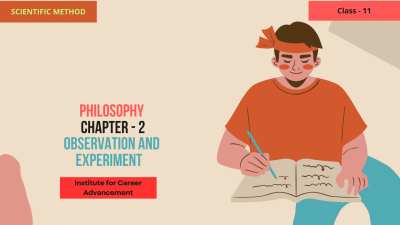
 Compare
Compare
Observation and Experiment in Class 11 focuses on the core principles of scientific inquiry. It delves into the fundamental steps involved in scientific investigations, emphasizing the crucial roles of observation and experimentation. Key Concepts: Observation: The process of carefully and systematically gathering information about the natural world using your senses. Types of observation: direct (using senses), indirect (using tools like microscopes, telescopes), qualitative (descriptive), quantitative (numerical). Importance of accurate and unbiased observation. Experimentation: A controlled procedure designed to test a hypothesis. Involves manipulating variables to observe their effects. Key components: Independent variable (the factor being manipulated). Dependent variable (the factor being measured). Control variables (factors kept constant). Designing experiments, collecting data, analyzing results, and drawing conclusions. একাদশ শ্রেণিতে পর্যবেক্ষণ ও পরীক্ষা বৈজ্ঞানিক অনুসন্ধানের মূল নীতিগুলির উপর দৃষ্টি নিবদ্ধ করে। এটি পর্যবেক্ষণ এবং পরীক্ষার গুরুত্বপূর্ণ ভূমিকার উপর জোর দিয়ে বৈজ্ঞানিক তদন্তের সাথে জড়িত মৌলিক পদক্ষেপগুলি নিয়ে আলোচনা করে। মূল ধারণাগুলিঃ পর্যবেক্ষণঃ আপনার ইন্দ্রিয় ব্যবহার করে সতর্কতার সাথে এবং পদ্ধতিগতভাবে প্রাকৃতিক জগৎ সম্পর্কে তথ্য সংগ্রহের প্রক্রিয়া। পর্যবেক্ষণের প্রকারঃ প্রত্যক্ষ (ইন্দ্রিয় ব্যবহার করে) পরোক্ষ (মাইক্রোস্কোপ, টেলিস্কোপের মতো সরঞ্জাম ব্যবহার করে) গুণগত (বর্ণনামূলক) পরিমাণগত (numerical). সঠিক ও নিরপেক্ষ পর্যবেক্ষণের গুরুত্ব। এক্সপেরিমেন্টঃ একটি নিয়ন্ত্রিত পদ্ধতি যা একটি অনুমান পরীক্ষা করার জন্য ডিজাইন করা হয়েছে। ভেরিয়েবলগুলিকে তাদের প্রভাবগুলি পর্যবেক্ষণ করতে ম্যানিপুলেট করা জড়িত করে। মূল উপাদানঃ স্বাধীন পরিবর্তনশীল (the factor being manipulated). নির্ভরশীল পরিবর্তনশীল (the factor being measured). নিয়ন্ত্রণ পরিবর্তনশীল (factors kept constant). পরীক্ষাগুলির নকশা করা, তথ্য সংগ্রহ করা, ফলাফল বিশ্লেষণ করা এবং সিদ্ধান্ত নেওয়া।
₹599
0 Lessons
Hours
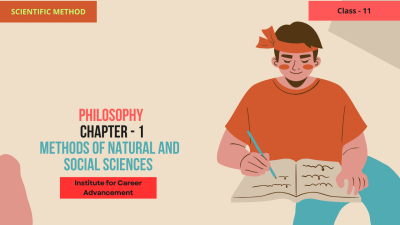
 Compare
Compare
This topic explores the distinct approaches used to investigate and understand the natural world and human societies. Natural Sciences: Focus: Study of the physical universe, including physics, chemistry, biology, and astronomy. Methods: Observation: Careful and systematic observation of natural phenomena. Experimentation: Controlled experiments to test hypotheses and gather data. Measurement: Precise and accurate measurements of variables. Data Analysis: Statistical analysis of data to identify patterns and draw conclusions. Hypothesis Testing: Formulating hypotheses and testing them through experimentation. Key Characteristics: Emphasis on objectivity and empirical evidence. Focus on identifying laws and principles that govern natural phenomena. Use of controlled experiments and quantitative data. Social Sciences: Focus: Study of human behavior, societies, and cultures, including psychology, sociology, anthropology, economics, and political science. Methods: Surveys: Collecting data through questionnaires and interviews. Observations: Observing human behavior in natural settings. Interviews: Conducting in-depth interviews with individuals or groups. Case Studies: In-depth analysis of specific individuals, groups, or events. Historical Analysis: Examining historical documents and events to understand social change. Comparative Analysis: Comparing different societies and cultures to identify similarities and differences. Key Characteristics: Emphasis on understanding human behavior and social interactions. Focus on qualitative data and subjective interpretations. Use of diverse research methods to gather data. Key Differences: Subject Matter: Natural sciences study the physical world, while social sciences study human behavior and societies. Research Methods: Natural sciences rely heavily on experimentation and quantitative data, while social sciences use a wider range of methods, including surveys, interviews, and observations. Focus: Natural sciences aim to identify universal laws and principles, while social sciences seek to understand the complexities of human behavior and social interactions. In summary, both natural and social sciences use rigorous methods to investigate and understand the world around us, but they differ in their subject matter, research methods, and focus. এই বিষয়টি প্রাকৃতিক বিশ্ব এবং মানব সমাজের অনুসন্ধান এবং বোঝার জন্য ব্যবহৃত স্বতন্ত্র পদ্ধতির অন্বেষণ করে। প্রাকৃতিক বিজ্ঞানঃ ফোকাসঃ পদার্থবিজ্ঞান, রসায়ন, জীববিজ্ঞান এবং জ্যোতির্বিজ্ঞান সহ ভৌত মহাবিশ্বের অধ্যয়ন। পদ্ধতিঃ পর্যবেক্ষণঃ প্রাকৃতিক ঘটনাগুলির যত্নশীল এবং নিয়মতান্ত্রিক পর্যবেক্ষণ। পরীক্ষা-নিরীক্ষাঃ অনুমান পরীক্ষা এবং তথ্য সংগ্রহের জন্য নিয়ন্ত্রিত পরীক্ষা-নিরীক্ষা। পরিমাপঃ চলকের সুনির্দিষ্ট এবং সঠিক পরিমাপ। তথ্য বিশ্লেষণঃ নিদর্শনগুলি সনাক্ত করতে এবং সিদ্ধান্তে পৌঁছানোর জন্য তথ্যের পরিসংখ্যানগত বিশ্লেষণ। অনুমান পরীক্ষাঃ অনুমান প্রণয়ন এবং পরীক্ষার মাধ্যমে সেগুলি পরীক্ষা করা। মূল বৈশিষ্ট্যঃ বস্তুনিষ্ঠতা এবং অভিজ্ঞতাগত প্রমাণের উপর জোর দেওয়া। প্রাকৃতিক ঘটনাকে নিয়ন্ত্রণ করে এমন আইন ও নীতিগুলি চিহ্নিত করার দিকে মনোনিবেশ করুন। নিয়ন্ত্রিত পরীক্ষা-নিরীক্ষা এবং পরিমাণগত তথ্যের ব্যবহার। সমাজবিজ্ঞানঃ মনোবিজ্ঞান, সমাজবিজ্ঞান, নৃতত্ত্ব, অর্থনীতি এবং রাষ্ট্রবিজ্ঞান সহ মানুষের আচরণ, সমাজ এবং সংস্কৃতির অধ্যয়ন। পদ্ধতিঃ সমীক্ষাঃ প্রশ্নাবলী এবং সাক্ষাৎকারের মাধ্যমে তথ্য সংগ্রহ করা। পর্যবেক্ষণঃ প্রাকৃতিক পরিবেশে মানুষের আচরণ পর্যবেক্ষণ করা। সাক্ষাৎকারঃ ব্যক্তি বা গোষ্ঠীর সঙ্গে গভীর সাক্ষাৎকার নেওয়া। কেস স্টাডিঃ নির্দিষ্ট ব্যক্তি, গোষ্ঠী বা ঘটনাগুলির গভীর বিশ্লেষণ। ঐতিহাসিক বিশ্লেষণঃ সামাজিক পরিবর্তন বোঝার জন্য ঐতিহাসিক নথি এবং ঘটনাগুলি পরীক্ষা করা। তুলনামূলক বিশ্লেষণঃ বিভিন্ন সমাজ ও সংস্কৃতির তুলনা করে সাদৃশ্য ও পার্থক্য চিহ্নিত করা। মূল বৈশিষ্ট্যঃ মানুষের আচরণ এবং সামাজিক মিথস্ক্রিয়া বোঝার উপর জোর দেওয়া। গুণগত তথ্য এবং বিষয়গত ব্যাখ্যার দিকে মনোনিবেশ করুন। তথ্য সংগ্রহের জন্য বিভিন্ন গবেষণা পদ্ধতির ব্যবহার। মূল পার্থক্যঃ বিষয় বস্তুঃ প্রাকৃতিক বিজ্ঞান ভৌত জগত অধ্যয়ন করে, অন্যদিকে সামাজিক বিজ্ঞান মানুষের আচরণ এবং সমাজ অধ্যয়ন করে। গবেষণা পদ্ধতিঃ প্রাকৃতিক বিজ্ঞান ব্যাপকভাবে পরীক্ষা-নিরীক্ষা এবং পরিমাণগত তথ্যের উপর নির্ভর করে, অন্যদিকে সামাজিক বিজ্ঞান জরিপ, সাক্ষাৎকার এবং পর্যবেক্ষণ সহ বিস্তৃত পদ্ধতি ব্যবহার করে। ফোকাসঃ প্রাকৃতিক বিজ্ঞানের লক্ষ্য সর্বজনীন আইন এবং নীতিগুলি চিহ্নিত করা, অন্যদিকে সামাজিক বিজ্ঞান মানুষের আচরণ এবং সামাজিক মিথস্ক্রিয়ার জটিলতা বোঝার চেষ্টা করে। সংক্ষেপে, প্রাকৃতিক এবং সামাজিক বিজ্ঞান উভয়ই আমাদের চারপাশের বিশ্বকে অনুসন্ধান ও বোঝার জন্য কঠোর পদ্ধতি ব্যবহার করে, তবে তারা তাদের বিষয়, গবেষণা পদ্ধতি এবং ফোকাসে পৃথক।
₹599
0 Lessons
Hours

 Compare
Compare
Kokbwkha:- I koklop (জাংগা বিসিংনি তকসা) o masa chobjak toksani khani kok sajak kha.Janga bisingo tongtwtwibo bini laiui phaimani eba agio tongwi phaimani kokrog muiti manjago.Tabuk bo bini cherai phuruni kok, buma buphani kok, sakchalairogni kok,birui beraima kok, akorog janga chobjak tongtwtwi muito manjakgwi imang hai ma tongjago.Janga bisingni yogwi bo buino bini khani kokrog sana muchungphano saui manya wngwi tongo.I chobjak toksa tabuk yogwi manya thwiui bo manya.Bini kha yogmano kebo bujinai kwrwi. Bini kha yogwi tentaimano bui kok sao se hino kebose bujinai kwrwi.I chobjak tok haino yogmung kwrwi hachal wansukma tei imang kwmajak borok munuisurogni bwkhani kok koklopnai bini koklopni bisingtwi sanani naikha.
1 Lessons
Hours
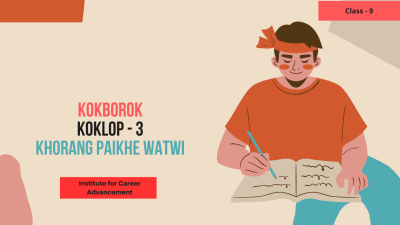
 Compare
Compare
o koklopni bisingtwi chwng saimano,huk khlai chanairog jephuru satung watwi nango aphuru mwtairog naikhlaio hinui saoi mano borokrog nang tongmani saimano.Abono surasauino khoroksa buma wngwi bwsano bwswk hamjak abono sajak o.
1 Lessons
Hours